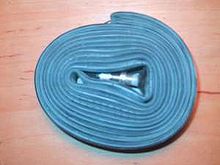
Back إطار دراجة Arabic Pneumàtic de bicicleta Catalan Шын (велосипед) CV Fahrradbereifung German Neumático de bicicleta Spanish Pneumatiko (bizikleta) Basque Polkupyörän rengas Finnish Pneumatique de bicyclette French 自転車用タイヤ Japanese Ban pit JV



A bicycle tire is a tire that fits on the wheel of a bicycle or similar vehicle. These tires may also be used on tricycles, wheelchairs, and handcycles, frequently for racing. Bicycle tires provide an important source of suspension, generate the lateral forces necessary for balancing and turning, and generate the longitudinal forces necessary for propulsion and braking. Although the use of a pneumatic tire greatly reduces rolling resistance compared to the use of a rigid wheel or solid tire, the tires are still typically the second largest source, after wind resistance (air drag), of power consumption on a level road.[1] The modern detachable pneumatic bicycle tire contributed to the popularity and eventual dominance of the safety bicycle.[2]
Bicycle tires are also used on unicycles, tricycles, quadracycles, tandem bicycles, hand cycles, bicycle trailers, and trailer bikes.
- ^ Wilson, David Gordon; Jim Papadopoulos (2004). Bicycling Science (Third ed.). The MIT Press. pp. 215–235. ISBN 0-262-73154-1.
Bicycle tire rolling resistance coefficients for smooth surfaces are widely accepted to range between 0.002 and 0.010
- ^ Herlihy, David V. (2004). Bicycle, The History. Yale University Press. p. 252. ISBN 0-300-10418-9.
As the pneumatic-tire safety gained popularity, the sport generated unprecedented popular interest.
© MMXXIII Rich X Search. We shall prevail. All rights reserved. Rich X Search